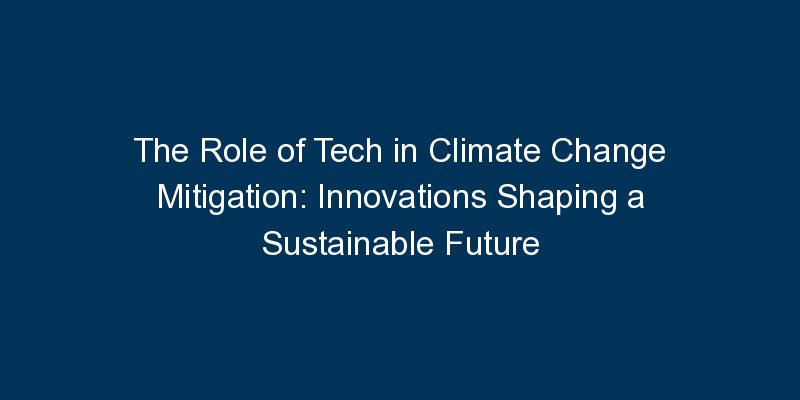Introduction
As the global community grapples with the pressing challenges of climate change, technology emerges as a powerful ally in the pursuit of sustainable solutions. This blog explores the pivotal role of technology in climate change mitigation, examining innovations, applications, and the transformative impact of tech-driven initiatives on the path to a greener, more sustainable future.
Tech Innovations Driving Climate Change Mitigation
1. Renewable Energy Technologies
a. Solar Power: Photovoltaic technology harnesses the power of the sun, converting sunlight into electricity. Solar panels are increasingly prevalent in residential, commercial, and industrial settings.
b. Wind Energy: Wind turbines generate electricity by harnessing wind power. Advances in turbine design and efficiency contribute to the growth of wind energy as a clean and renewable resource.
2. Energy Storage Solutions
Innovations in energy storage, such as advanced batteries and grid-scale storage systems, address the intermittent nature of renewable energy sources. Storage technologies ensure a consistent and reliable power supply, even when the sun isn’t shining or the wind isn’t blowing.
3. Smart Grids for Energy Efficiency
Smart grid technology enhances energy distribution and consumption efficiency. These grids use sensors, automation, and real-time data analytics to optimize energy usage, reduce waste, and enhance the overall reliability of power systems.
Sustainable Transportation Technologies
4. Electric Vehicles (EVs)
The rise of electric vehicles is a key driver in reducing carbon emissions from transportation. EVs, powered by electricity instead of fossil fuels, contribute to cleaner air and a lower carbon footprint in the transportation sector.
5. High-Efficiency Public Transportation Systems
Innovations in public transportation, such as high-speed rail and electric buses, offer sustainable alternatives to traditional modes of transportation. These systems reduce reliance on individual car travel and promote environmentally friendly commuting options.
Carbon Capture and Removal Technologies
6. Direct Air Capture (DAC)
DAC technologies remove carbon dioxide directly from the atmosphere. These innovations play a crucial role in offsetting emissions from sectors that are challenging to decarbonize completely.
7. Afforestation and Reforestation Initiatives
Utilizing technology for large-scale afforestation and reforestation efforts aids in sequestering carbon and restoring ecosystems. Drones and satellite imaging contribute to monitoring and managing these projects effectively.
Climate Monitoring and Data Analytics
8. Satellite Technology for Climate Observation
Satellites equipped with advanced sensors provide valuable data for monitoring climate patterns, deforestation, and changes in land use. This data is instrumental in understanding the impacts of climate change and formulating effective mitigation strategies.
9. Machine Learning for Climate Modeling
Machine learning algorithms enhance climate modeling, helping scientists make more accurate predictions about climate trends, extreme weather events, and the potential impacts of climate change on different regions.
Challenges and Considerations
10. Technological Barriers and Affordability
The accessibility and affordability of sustainable technologies pose challenges, particularly in developing regions. Bridging the technological gap and ensuring widespread adoption are crucial for effective global climate change mitigation.
11. Resource Extraction and Environmental Impact
The production of renewable technologies, such as solar panels and batteries, involves the extraction of raw materials. Balancing the benefits of these technologies with their environmental impact is a critical consideration in achieving sustainable practices.
Future Trajectories and Global Collaboration
12. International Cooperation for Climate Tech Advancements
Global collaboration is essential for accelerating the development and deployment of climate technologies. International partnerships, knowledge sharing, and collaborative research efforts contribute to a unified approach in addressing the challenges of climate change.
13. Continued Innovation and Adaptation
The dynamic nature of climate change necessitates ongoing innovation and adaptation. The tech sector’s commitment to continuous improvement and the development of scalable solutions will be pivotal in meeting the evolving challenges of a changing climate.
Conclusion
The role of technology in climate change mitigation is not just about finding solutions; it’s about shaping a sustainable future for generations to come. From harnessing renewable energy to employing cutting-edge data analytics, technology is at the forefront of the battle against climate change.
As we navigate the complex landscape of climate change, the integration of technology becomes a beacon of hope. By fostering innovation, addressing challenges, and promoting global collaboration, we pave the way for a greener, more resilient planet—one where technology acts as a catalyst for positive environmental change.

















Comments